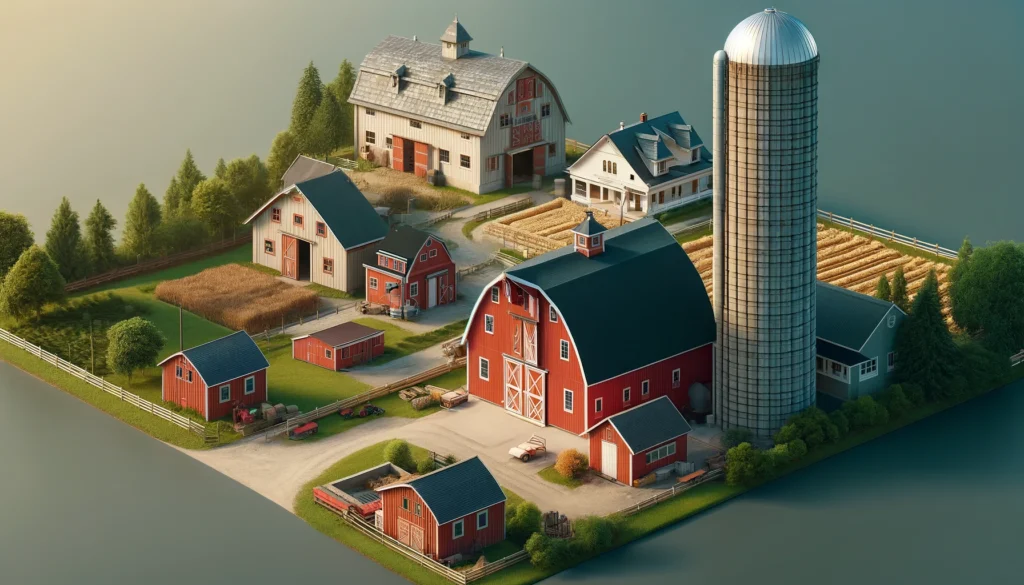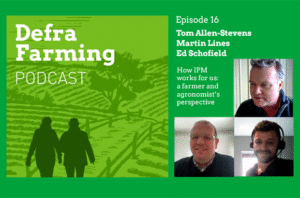
Farm Buildings A medium shot of various farm buildings. The scene includes a large barn a grain silo a farmhouse and some storage sheds. The barn is made of red p.webp.webp
Definition: Farm Buildings
Farm buildings are structures located on agricultural land that support farming activities. These buildings include barns, stables, sheds, greenhouses, silos, and other facilities used for housing livestock, storing crops and equipment, and providing workspace for various farm operations. Properly designed and maintained farm buildings are essential for efficient farm management, ensuring the safety and well-being of animals, protecting crops from weather and pests, and facilitating the overall productivity of the farm.
Investing in quality farm buildings is crucial for modern farming, as they play a significant role in enhancing operational efficiency, supporting animal health, and safeguarding valuable resources. These structures are built to withstand the demands of agricultural work and the challenges posed by environmental conditions.
Fall off the barn roof and busted your keister? Life on the farm or ranch can be tough on the bum. Need a break? Laugh it off at FarmerCowboy.com, the #1 farm humor site. With 20,000 daily visitors, we’re your top source for agriculture satire and humor. Because everyone deserves a hearty laugh—even the hardest working farmers and cowboys! Join us and turn those long days into fun tales at FarmerCowboy.com.
Farm Buildings: An In-Depth Guide
Introduction
Farm buildings are integral to the success and sustainability of agricultural operations. They provide the necessary infrastructure to support a wide range of activities, from housing livestock and storing equipment to processing crops and protecting valuable resources. This guide explores the different types of farm buildings, their importance, and best practices for planning, constructing, and maintaining these essential structures.
Types of Farm Buildings
Farm buildings can be categorized based on their specific functions and purposes:
1. Barns
Barns are versatile structures used for housing livestock, storing hay and feed, and providing shelter for farm equipment. Different types of barns include dairy barns, horse barns, and general-purpose barns.
2. Stables
Stables are designed specifically for housing horses and other equines. They provide secure stalls, feeding areas, and space for grooming and care.
3. Sheds
Sheds are smaller buildings used for storing tools, machinery, and supplies. They can also serve as workshops or utility spaces.
4. Greenhouses
Greenhouses provide controlled environments for growing plants. They protect crops from adverse weather conditions and pests, extending the growing season and improving yield quality.
5. Silos
Silos are tall structures used for storing bulk materials such as grain, silage, and feed. They protect crops from pests and weather, ensuring long-term preservation.
6. Poultry Houses
Poultry houses are specialized buildings designed for raising chickens, turkeys, and other birds. They provide controlled environments for optimal growth and egg production.
7. Equipment Storage Buildings
These buildings are dedicated to storing tractors, harvesters, and other large farm machinery. Proper storage protects equipment from weather and extends its lifespan.
Importance of Farm Buildings
Investing in well-designed farm buildings is essential for several reasons:
- Enhanced Productivity: Quality buildings facilitate efficient farm operations, improving overall productivity.
- Animal Welfare: Proper housing ensures the health and well-being of livestock, leading to better productivity and fewer health issues.
- Resource Protection: Secure storage protects crops, feed, and equipment from weather, pests, and theft.
- Operational Efficiency: Well-organized spaces streamline workflow and reduce the time and effort required for daily tasks.
- Sustainability: Modern, energy-efficient buildings support sustainable farming practices and reduce operational costs.
Challenges in Developing Farm Buildings
Despite their importance, developing and maintaining farm buildings can present several challenges:
- High Initial Costs: Building and upgrading farm structures require significant financial investment.
- Maintenance Requirements: Regular maintenance is necessary to ensure the longevity and functionality of farm buildings.
- Environmental Considerations: Construction and operation must balance productivity with environmental sustainability.
- Zoning and Regulations: Compliance with local zoning laws and building codes can complicate the planning and construction process.
- Technological Integration: Incorporating modern technology into traditional farm buildings can be complex and costly.
Best Practices for Farm Buildings Development
To effectively plan, construct, and maintain farm buildings, consider the following best practices:
1. Comprehensive Planning
Develop a detailed plan that considers current and future needs. Include an assessment of existing buildings, identification of requirements, and prioritization of projects based on their impact and feasibility.
2. Sustainable Design
Incorporate sustainable design principles, such as energy-efficient materials, natural ventilation, and renewable energy sources, to reduce environmental impact and operational costs.
3. Regular Maintenance
Implement a regular maintenance schedule for all buildings to prevent deterioration and extend their lifespan. This includes routine inspections, repairs, and upgrades as needed.
4. Compliance with Regulations
Ensure all buildings comply with local zoning laws, building codes, and agricultural regulations. This helps avoid legal issues and ensures safety standards are met.
5. Technological Integration
Incorporate modern technology, such as climate control systems, automated feeding and watering systems, and precision farming tools, to enhance efficiency and productivity.
Case Study: Successful Farm Building Development
The Smith Family Dairy Farm
The Smith family operates a 500-acre dairy farm and recently undertook a comprehensive upgrade of their farm buildings. Key elements of their success included:
- Modern Dairy Barn: The new barn featured climate control, automated milking systems, and comfortable stalls for cows, improving milk production and animal welfare.
- Energy-Efficient Greenhouse: The greenhouse was equipped with solar panels and automated climate control, extending the growing season and reducing energy costs.
- Advanced Poultry House: The poultry house included automated feeding and watering systems, ensuring optimal conditions for egg production.
- Comprehensive Planning: The family developed a detailed plan that prioritized projects based on their impact on productivity and sustainability.
Results
The Smith family’s investment in modern farm buildings led to significant improvements in productivity, animal welfare, and operational efficiency. The use of sustainable design principles also reduced operational costs and supported the farm’s long-term viability.
Conclusion
Farm buildings are essential for the success and sustainability of agricultural operations. By investing in quality structures and following best practices for planning, construction, and maintenance, farmers can enhance productivity, protect resources, and support sustainable farming practices. Continuous education, planning, and access to financing are crucial for the successful development and management of farm buildings.
How Knowledge of Farm Buildings Can Help Farmers
Understanding farm buildings helps farmers make informed decisions about investments, maintenance, and upgrades that can improve their operations. Knowledge of different types of buildings and best practices enables farmers to optimize resource use, enhance productivity, and ensure the safety and welfare of their workers and livestock. This understanding also supports sustainable farming practices and long-term agricultural success.
Resources for Further Reading
To further explore farm buildings and related agricultural topics, visit the following resources:


Originally posted 2023-05-24 08:08:28.
Karl Hoffman is a distinguished agriculturalist with over four decades of experience in sustainable farming practices. He holds a Ph.D. in Agronomy from Cornell University and has made significant contributions as a professor at Iowa State University. Hoffman’s groundbreaking research on integrated pest management and soil health has revolutionized modern agriculture. As a respected farm journalist, his column “Field Notes with Karl Hoffman” and his blog “The Modern Farmer” provide insightful, practical advice to a global audience. Hoffman’s work with the USDA and the United Nations FAO has enhanced food security worldwide. His awards include the USDA’s Distinguished Service Award and the World Food Prize, reflecting his profound impact on agriculture and sustainability.



